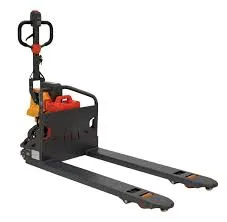


The Rise of Pedestrian Powered Pallet Trucks A Sustainable Solution for Modern Warehousing
In the era of rapid industrialization and increasing demand for efficient logistics operations, the traditional methods of material handling are being re-evaluated. One of the innovations that have emerged is the pedestrian powered pallet truck, a solution that combines efficiency with sustainability. This article explores the benefits and operational strategies of pedestrian powered pallet trucks, and their significant role in modern warehousing.
Understanding Pedestrian Powered Pallet Trucks
Pedestrian powered pallet trucks are manually operated vehicles designed for the easy transport of goods across short distances within warehouses and distribution centers. Unlike traditional pallet trucks, which rely solely on human strength, pedestrian powered models are equipped with electric assistance that enhances their functionality. This electric support allows operators to move heavier loads without straining themselves, promoting safer work environments.
The design typically includes a low-profile base for loading pallets, an ergonomic handle for easy control, and a robust power system that facilitates movement over varying surfaces. These trucks are battery-operated and can be recharged efficiently, making them an eco-friendly alternative to powered forklifts, particularly in small to medium-sized operations.
Environmental Benefits
One of the remarkable advantages of pedestrian powered pallet trucks is their reduced environmental impact. As businesses strive to attain sustainability goals, these trucks provide a green alternative to gas-powered forklifts. Their electric motors emit zero emissions during operation, which helps improve air quality within warehouses—a critical factor considering the cramped environment of many storage facilities.
Additionally, the use of electric-powered trucks diminishes noise pollution, creating a quieter working atmosphere that benefits employees. Companies adopting these trucks can not only enhance their operational efficiency but also contribute to a healthier environment, aligning with corporate social responsibility objectives.
Operational Efficiency

The implementation of pedestrian powered pallet trucks can significantly boost operational efficiency. By allowing one operator to handle heavier loads with reduced physical labor, businesses can streamline their material handling processes. The increased maneuverability of these trucks makes them ideal for navigating tight spaces often found in warehouses, improving the flow of goods from storage to shipping areas.
Moreover, pedestrian powered pallet trucks are generally more cost-effective than traditional fork trucks. They require less maintenance, and their lower upfront cost can be an attractive option for small to medium-sized enterprises. Unlike larger powered equipment, they also do not necessitate specialized training for operators, further reducing operational overhead and enhancing labor flexibility.
Safety Improvements
Safety is paramount in warehouse operations, and pedestrian powered pallet trucks contribute positively to this aspect. Their design emphasizes user safety, with features such as emergency stop buttons and anti-roll mechanisms. The low height of these trucks minimizes the risk of accidents, as they can be operated with full visibility of the surroundings.
Furthermore, the ability to move loads without excessive manual handling lowers the risk of injuries associated with lifting and carrying, such as strains and sprains. By fostering a safer working environment, businesses can reduce workplace incidents and improve employee morale, leading to higher productivity.
Conclusion
As the logistics landscape continues to evolve, the pedestrian powered pallet truck emerges as a leader in sustainability, efficiency, and safety. With their eco-friendly operation and enhanced functionality, these trucks are transforming how goods are handled in warehouses and distribution centers. By investing in this innovative equipment, businesses not only enhance their operational capabilities but also commit to a greener future, paving the way for sustainable industrial practices.
In conclusion, adopting pedestrian powered pallet trucks represents a forward-thinking choice for organizations looking to improve their material handling processes while fulfilling their environmental responsibilities. As we look to the future, the integration of such technologies will be paramount in achieving efficiency and sustainability in the ever-changing world of logistics.



